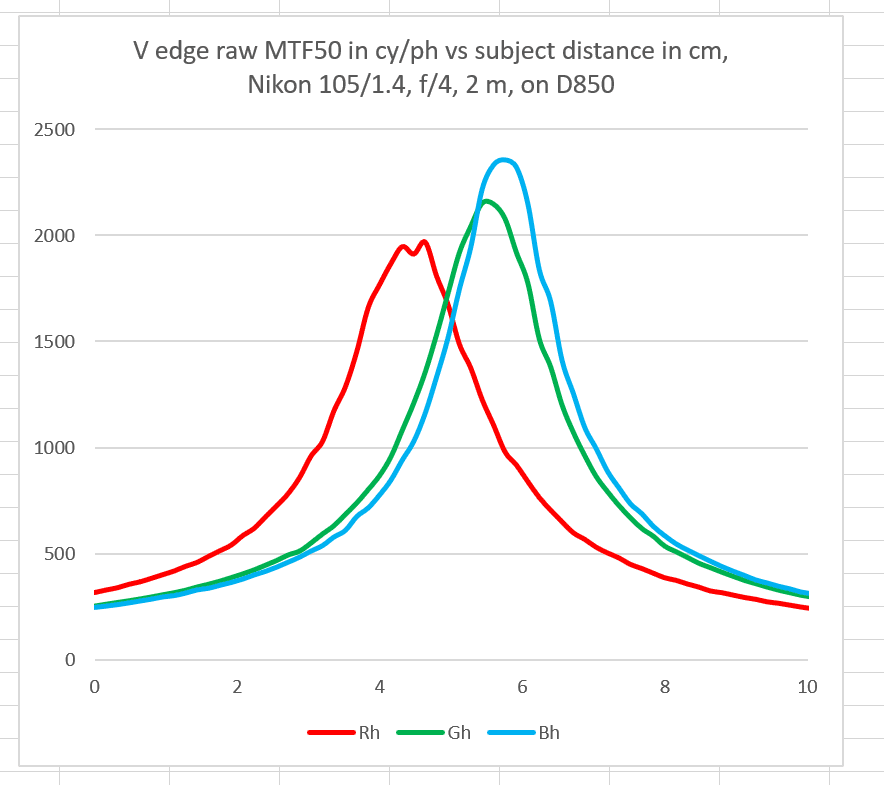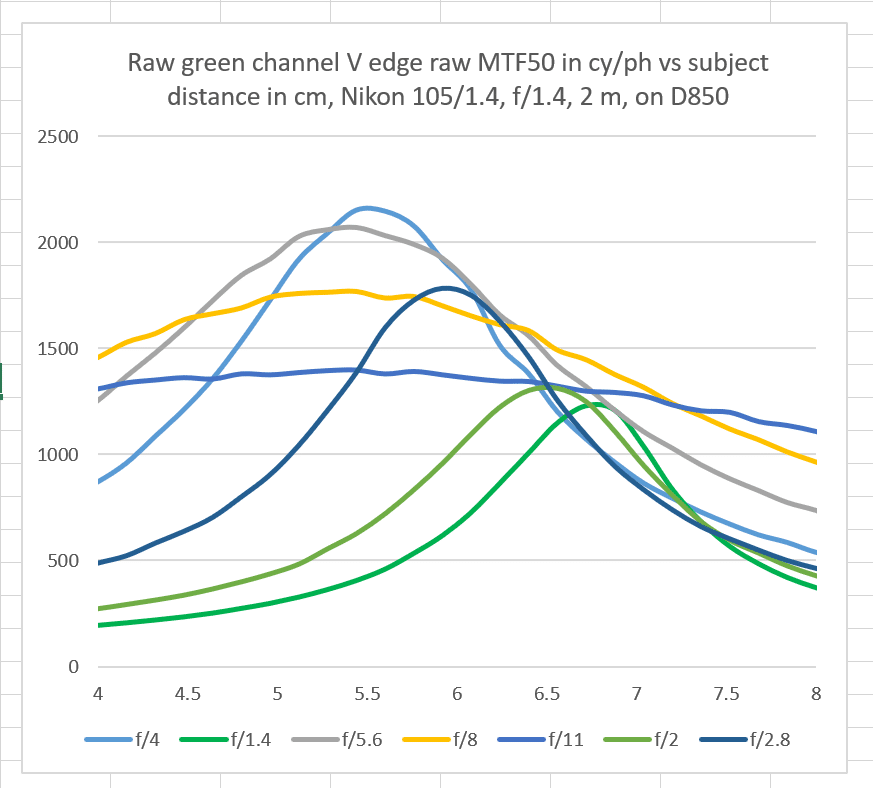This is the seventh post in a series of Nikon D850 tests. The series starts here.
Actually, this isn’t really a D850 test. It’s a test of a Nikon 105 mm f/1.4 lens that happens to be mounted to a D850. The performance of the combination is what I’m testing. We saw some anomalies in the D850 autofocus test with that same 105/1.4 lens, and the purpose of this test is to take the measure of the lens on the D850 so we can judge the autofocus results in context.
I made a series of exposures at each whole f-stop from f/1.4 through f/11, using a motorized rail and this protocol:
- Nikon D850
- Double-edged razor blade backlit with Wescott LED panels aimed at white diffuser
- ISO 64
- Manual exposure
- Manual focus, set at one position
- Cognisys computer-driven focusing rail
- 100 exposures 1.6 mm apart
- 2 meters to target in the middle of the rail
- Document mode decoding with DCRAW
- MTF50s for all the raw color planes calculated using MTF Mapper
- Graphing in Excel
Here’s a picture of the test setup:
The controller for the rail is in the basket attached to the tripod legs. The rail is mounted to a Arca Swiss C1, and the camera is mounted to the rail. The tripod in front of the camera has the razor blade. Behind that is the white paper diffuser. You can see one of the Wescott LED panels in the upper left; the other is hidden behind the camera.
Here are the results at f/1.4:
Camera motion in cm is plotted as the horizontal axis, with the left-hand side having the subject further from the camera than the right-hand side (The camera moves closer to the subject by 16o micrometers after each exposure). Total travel was 160 mm, or 16 cm. I’ve chopped off the nearest 6 cm since there was nothing of interest happening there. The vertical axis is MTF50 in cycles per picture height (cy/ph), which is a good proxy for sharpness.
The lens is only moderately sharp wide open. There is a fair amount of longitudinal chromatic aberration (LoCA) that shows up as the red channel peaking at a different distance than the green and blue ones. The red is also not as sharp; that is usually the case for a fast lens wide open.
Stopping down in one-stop intervals:
It is not until at least f/8 that the depth of field is adequate to cover up the LoCA.
Plotting all the green channel data on the same graph allows us to look at focus shift, and also to easily see the sharpest f-stops. I’ve expanded the distance axis for easier viewing:
The plane of focus moves further away from the camera as the lens is stopped down. The lens is very sharp from f/2.8 to f/8. There is a lot of focus shift. It’s going to be very difficult for PDAF autofocus systems that focus at an effective aperture of f/4 or narrower to get decent performance that wide apertures. I don’t know the details of the Nikon D850 PDAF system; perhaps someone can enlighten me. For manual focusing, I recommend focusing at the taking aperture for f/4 and wider shots. For narrower apertures than f/4, you can safely focus at f/4.
The absolute numbers for MTF50 are not comparable to the AF results published earlier, for two reasons. The most important one is that the razor blade provides a sharper target than the printed slanted edge I used for the AF testing. The less important one is that these tests were performed at 2 meters, and the AF tests were done at 3 meters. Still, the differences are so large that I suspect that even with CDAF the camera’s autofocus system is not getting all the sharpness out of the lens that it can deliver if optimally focused.
I tried testing CDAF autofocus system on the razor blade target. It was totally unable to acquire focus at any of the 7 apertures used in this test.
If you look hard at the focus shift above, it’s an obvious question how the AF system did as well as it did in the preceding post. Here’s the answer, from Marianne Oelund, who is a Nikon expert:
…if you need to move back and forth between the widest apertures, and moderate ones, AF will be problematic, especially with camera bodies released prior to 2014 (starting that year, Nikon incorporated focus-shift compensation into the AF system – without telling anyone, of course).
Here are results tests of two excellent lenses with the same target at similar distance with different cameras:
The a7RII has slightly lower resolution than the D850, so it is at somewhat of a disadvantage in the above test. Note how well it does wide open in comparison to the 105/1.4.
The GFX has more resolution than the D850, and also smaller microlenses, so it has an advantage. Both of these lenses have far lower focus shift than the Nikon on tested here.











Your description of the horizontal axis of the graphs is confusing. In one place, you state that the numerical labels are subject distance in cm, and those labels increase from left to right. But in another place you state: “…the left-hand size [side?] having the subject further from the camera than the right-hand side”. Which is correct?
As you change aperture from f/1.4 to f/4 does the plane of focus shift closer to the camera or further away? I tried a very quick and crude test with my own D850 and 105mm f/1.4E, using only a flat focus target (parallel to sensor) and a ruler on a table. Visually inspecting shots made at f/4 with PDAF, I could not see any obvious focus shift. Does this indicate Marianne’s comment is correct, and that the camera is applying compensation?
I’ve changed the description in a way that I hope will add clarity: “Camera motion in cm is plotted as the horizontal axis, with the left-hand side having the subject further from the camera than the right-hand side (The camera moves closer to the subject by 160 micrometers after each exposure). ”
The focal plane moves away from the camera as the lens is stopped down.
In your test, were you using AF?
The text in the graphs describe the horizontal axis as “subject distance.” But that’s wrong. In your comment above, you confirm that the axis is actually representing camera travel distance on the slide, which increases as it moves closer to the subject. Do you see why this could confuse readers?
Thanks for publishing your tests and for confirming the direction of the focus shift, as what I expected.
As for my simple and crude test… I had camera on tripod, aimed at a high contrast target parallel to sensor plane. Target was a bit over one meter from camera. A ruler was placed next the target, similar to the configuration of the LensAlign rig. I used viewfinder auto focus (PDAF) at f/4, and examined the shots to see if the plane of focus on the ruler matched the target position. Certainly not a precise test. But I did not notice obvious focus shift.
From what I understand, your methodology isolates the focus shift behavior of the lens alone. My simple test includes the behavior of lens and AF system, plus possible focus shift compensation in the camera’s software. I would love to see if your instrumented rig could measure how effective that compensation works, when the AF is in the loop. If there is an effective compensation applied, it would also be interesting to learn whether it is applied only for Nikon’s own lenses, or for others, too.
Yes, I see that that is confusing if the text is not understood. What should I call it? Relative camera position? Or invert the scale and call it “relative subject distance”?
Unfortunately, the combination of the PDAF system in the D850 and the optical qualities of the 105/1.4 result in a system that is has way too much noise for the test you’re envisioning, as you can see by my AF tests. The D850 is also completely unable to acquire focus on the razor blade. Not sure why.
It’s probably not worth the effort to regenerate all the graphs with new labeling. But you might edit your intro text to emphasize that the horizontal axis measures relative motion on the slide, and that increasing values indicate positions CLOSER to the target. That would, at least, let readers recognize the correct direction of the focus shift.
I made the relevant text bold.
” I don’t know the details of the Nikon D850 PDAF system; perhaps someone can enlighten me. For manual focusing, I recommend focusing at the taking aperture for f/4 and wider shots. For narrower apertures than f/4, you can safely focus at f/4.”
An excellent series of posts by Marianne Oelund are on the DPRreview discussion board.
Starts Here:
https://www.dpreview.com/forums/post/54211983
The pertinent section describing the field of view of the autofocus separator lenses is here:
https://www.dpreview.com/forums/post/54212041
The autofocus system looks at just inside f/5.6. With a lens that has a forward focus shift such as the Nikon 105 1.4 AFS, the focus will move backward when autofocus focuses at f/5.6 and the shooting aperture is f/1.4
Thanks for an excellent series of tests. Very informative.
Thanks, Bill. That’s a great set of posts. As usual, Marianne is clear, quantitative, and credible.
This is especially sobering:
https://www.dpreview.com/forums/post/54240689
Comparing the data between the 105 1.4 E & Sigma Art 135 1.8, looks like the Sigma might be better overall (with the understanding they’re different focal lengths so not apples to apples).
Would you agree with that assessment?
I’d call it pretty close to a wash for on-axis sharpness and LoCA. Note I couldn’t test the 135 at f/1.4, and I didn’t test the 105 at f/1.8.
OK, thanks.
I should probably emphasize that when we get to this level of performance, it is highly unlikely that the lens is going to be the thing that keeps images made with it from being successful. It is far more likely that it will be the photographer.
Well-said. That’s realistic. If I can consistently improve my technique to the point that I’m getting say 90% of the performance from the complete system, I want a top-notch lens (like the 105 1.4 E or Sigma 135 1.8 Art). I have the new Nikon 70-200 2.8 E as well and it’s awesome. I’d like to see Nikon do a refresh of the 200/2. Probably be crazy expensive though no doubt.